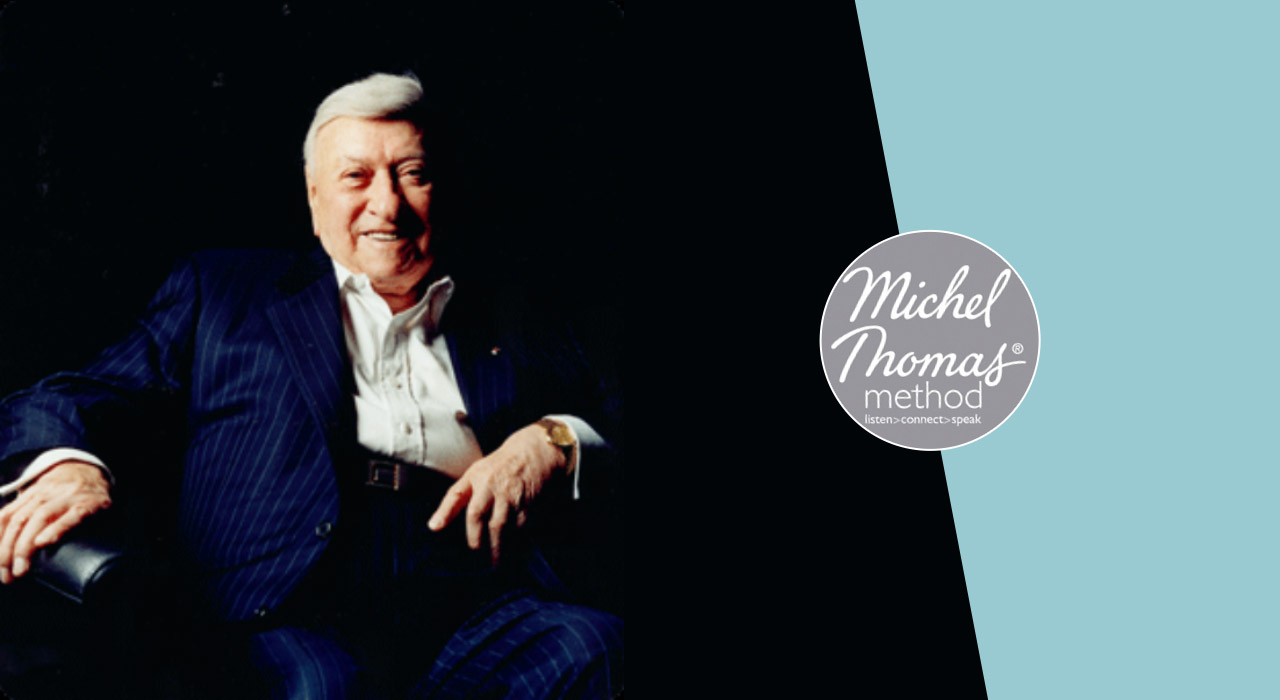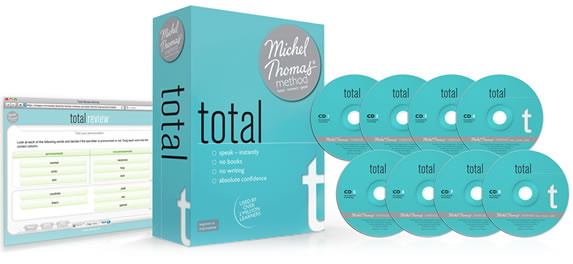Review: The Michel Thomas Method for Language Learning
What is The Michel Thomas Method?
The Michel Thomas method is a popular approach in language learning with a range of audio language courses available for beginners. You learn by pausing the audio and translating the teacher’s spoken phrases into the target language
- what it’s for:
- Basic conversation material, listening comprehension, speaking practice
- languages:
- Spanish, French, German, Korean, Japanese, Italian, Chinese (Mandarin), Arabic (Egyptian) Modern Standard Arabic, Russian, Portuguese, Dutch, Polish, Swedish, Norwegian, Irish, Greek, Hindi
- level:
- Beginner
+ PROS
- 100% audio, no reading or writing
- Learn words and phrases that you’ll use in the real world
- Avoids teaching overly specific vocabulary
- Helpful for quickly building a base in the target language that you can use in real conversations
- Covers all the major verb tenses
- Good amount of repetition
- CONS
- Skips the initial pleasantries of conversations (e.g. “What’s your name?”)
- Lack of polite conversation fillers
- Late introduction of the formal ways to address people
- No way to track progress
The Michel Thomas Method is a popular approach in language learning, with a range of language courses available for beginners. British newspaper The Times has called the Michel Thomas Method “The nearest thing to painless learning.” So, we decided to do our own Michel Thomas review.
Michel Thomas courses are all in audio, and you learn by pausing the audio and translating the teacher’s spoken phrases into the target language.
Over time, you’re encouraged to use the phrases you’ve learned as building blocks to create longer sentences.
There are plenty of good reviews on Amazon (the Spanish course scores an average of 4.3 stars).
But does it work in practice?
I took on the challenge of completing the full Michel Thomas Total Portuguese course to see what happened.
I started as an absolute beginner…and I’ll share exactly how it worked for me.
Here are my thoughts – plus later on I’ll share a video of myself speaking Portuguese after completing the course.
Michel Thomas Review: Getting Started
Michel Thomas courses are designed for absolute beginners. They purposely avoid great depth, and instead focus on helping you have a variety of simple conversations, for example, while on holiday.
I found the course incredibly easy to understand and get started.
In particular, I really enjoyed that the course is 100% audio. No videos, no flashcards. No reading or writing. I could sit there with my eyes closed and not worry about writing stuff down or watching for visual and audio clues at the same time.
In the audio, you join two other students in a virtual “classroom”. You listen in on the students’ lesson, and complete simple language challenges with them. When the other students are asked to translate a phrase, you’re meant to pause the playback, and translate it yourself first.
I liked this method of learning.
Michel Thomas Review: What Did I Learn?
I found that the Michel Thomas course was relevant to the real world. In taking the course, I learned words and phrases that every student should learn early on.
There are no useless sentences like “The business meeting has been moved to the yacht”, which only a certain type of traveler would want to learn.
Instead, you learn phrases like:
- “Why don’t you want to go there today?”
- “Where did you eat yesterday?”
- “I don’t need this, but I want it.”
The Michel Thomas course avoids teaching a lot of specific vocabulary, which saves you from memorising.
How does this work? Rather than teaching a big list of nouns, it teaches “this”, “that” and “it”, so you can at least point to an object and talk about it without knowing its name.
I commend the course creators for trying to appeal to as wide an audience as possible. I can now talk about a variety of topics without needing to know a whole lot of specific vocabulary. I can point to an object and say, “How much does that cost?”, or point to a museum and say, “Let’s go there tomorrow.” Phrases like this would certainly come in handy on a short trip to a Portuguese-speaking country.
However, while I found this an effective way to learn the basics of Portuguese, it’s not all that helpful during video conversations, as you’ll see from my video at the end of this article! When it’s just you and the other speaker, there’s nothing to point at; you need to know the actual words for the items you’re talking about.
In addition, the course manages to cover all of the major verb tenses, which is unusual in a course for absolute beginners (I studied French for five years in school before I learned the future tenses!).
All that said, I did have some issues with the Michel Thomas approach.
I noticed that the course skipped over virtually all pleasantries that you would expect to exchange with any new person you meet in your target language. No “What’s your name?”, “How are you?” or “Where are you from?” I had my first Portuguese lesson online after completing the course, and I couldn’t even say, “My name is Holly”!
I would have really liked to learn some more “greeting”-type vocabulary, so that I can walk up to a vendor, for example, and say “Hi, how are you? Nice day today” instead of launching right into, “How much is that?”
The title of the course is “Total Portuguese”, but I feel like this is a bit of an overstatement. It does teach useful material, but it only teaches the basics. No more, no less.
As an additional aside, the course focuses only on the most formal way to address people in Portuguese until very late in the course. I found this frustrating. When I started using Portuguese on italki, my teachers used the informal “tu” form of verbs, and expected me to do the same. But the Michel Thomas method encourages near-exclusive use of the formal forms “o senhor”/”a senhora” and “você”, meaning I was very inexperienced with the “tu” form, which is conjugated quite differently.
Overall, I’d say I learned a lot of useful phrases – but not enough to be a well-rounded Portuguese speaker, even at beginner level.
Michel Thomas Review: Did I Actually Remember What I Learned?
A big part of learning another language is motivation. Being accountable to another person (or a teacher) and tracking your progress can be a huge help with staying motivated.
How does the Michel Thomas method fare here?
Michel Thomas is a static course, so there’s no teacher to keep you accountable. But because the course is so easy to follow (“No homework! No memorizing!”), there’s really nothing for you to shy away from.
The course is completely in audio – available in CD or audiobook format. I went with the CD option, and it was easy and pleasant enough for me to listen to a CD every day. I never looked for any excuses not to sit down and listen to the course.
I was really pleased with the amount of repetition in the course. The material wasn’t particularly diverse, but the teaching method made darn sure that I wouldn’t forget the words and phrases that I learned. The teacher accomplishes this by incrementally introducing new material, and then instantly quizzing the students (and me, the listener) on that and previous material.
The material was just challenging enough to hold my attention. But it can easily become boring if you don’t use it the way it’s intended. You need to make a genuine attempt at answering the teacher’s questions before moving on, or else the material will just wash over you and you’ll forget it.
I would try to guess the correct answer to all of the teacher’s questions (out loud!) before the students in the studio could. It wasn’t so easy that I always guessed correctly, and I appreciated the challenge of this.
It really helped to listen to two other students learn at the same time as me. They usually asked the same questions that I would have if I had been having a live lesson. This almost made me feel like I was taking an interactive lesson, which helped my motivation even more.
Other than working your way through the classes, there’s no real way to track your progress. That said, I don’t think that the course intends to help you track your progress.
It certainly makes sure you do progress, by quizzing you constantly on both old and new material. But it falls short of actually measuring it. However, after the audio course is complete, the last CD includes a series of tests to check your knowledge. You’re then provided with a score. This is the one place in the course where you can get a concrete measurement of your total progress.
One more thing: All of the repetition and the teacher’s corrections were fabulous for my pronunciation. I surprised my Skype teacher in my first lesson with how good my Portuguese pronunciation was. But she was also surprised at how limited my vocabulary was! The course really does teach absolute basics for getting by; not having a detailed conversation in the language.
Michel Thomas Method: The Verdict
Would I use the Michel Thomas Method again? That is to say – was it worth the time and effort?
Quick answer: I would use it again, but with some caveats.
The Michel Thomas course claims that you’ll “go from absolute beginner to confident speaker” in Portuguese. And technically, I did! The words and phrases that the course teaches (however limited) I learned very well and could use confidently.
When I use Michel Thomas in the future, I’ll definitely use it as a supplement to my other studies in the target language, rather than as a standalone resource. For Portuguese, however, I didn’t want to use any other study methods, or else I wouldn’t have an accurate idea of exactly what the Michel Thomas course can and can’t do for absolute beginners. After using only Michel Thomas as my first exposure to Portuguese, I can conclude that while it’s helpful, it doesn’t go the full distance on its own.
For my next language mission (whatever that might be!), if a Michel Thomas course exists for that language, I would use it. It’s a low-stress way to get over that initial hump, from being able to say nothing in the language to being able to say a variety of phrases.
The course brought me from knowing absolutely zero Portuguese – not even “yes” or “no” – to being able to confidently have quite a few short, very simple exchanges.
You can pick up Michel Thomas Total Portuguese on Amazon.
My Video Speaking Portuguese After Competing Michel Thomas
Once I’d completed Michel Thomas Total Portuguese I made a video of myself chatting with a native speaker. To prepare for this video, I had three lessons on italki after I’d finished the Michel Thomas course.
Here’s the video (which actually became the start of a Portuguese in 3 Months mission):
I enjoyed learning Portuguese so much that I decided to take on a Portuguese in 3 Months Mission after finishing the Michel Thomas course. You can read more about my mission here.




Social